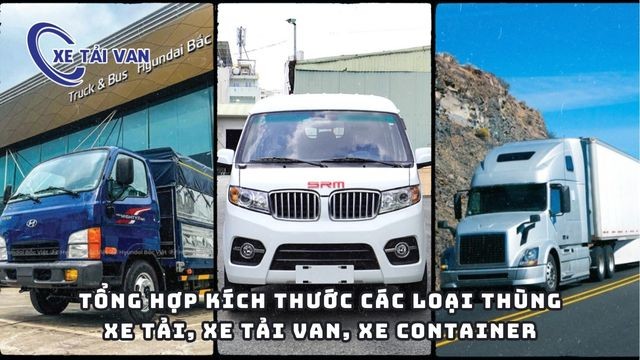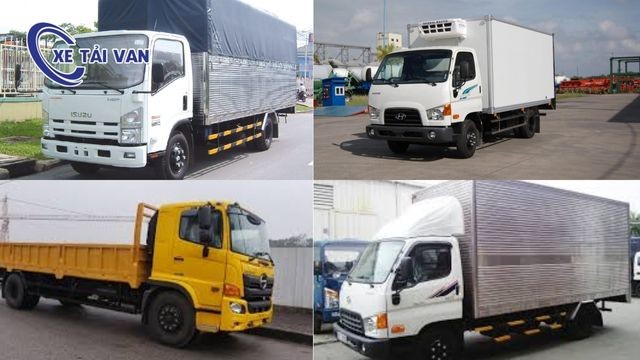Understanding truck bed sizes is crucial when you decide to purchase a truck, van, or container for your transportation business. Knowing the types of truck beds and suitable dimensions not only optimizes transportation efficiency but also ensures compliance with legal regulations. This article from My Dinh Truck, a reputable truck website, will provide the most detailed and comprehensive information on truck bed sizes today, helping you make the most informed decision.
 Overview of truck bed sizes for various types of trucks, vans, and containers
Overview of truck bed sizes for various types of trucks, vans, and containers
Common Types of Truck Beds for Cargo Transportation Today
Before delving into truck bed sizes, differentiating between types of truck beds for cargo is essential. The Vietnamese truck market is diverse, with each type of truck bed designed to meet different cargo transportation needs. Below are common types of truck beds you often see on the streets:
- Flatbed Truck Bed: This is the most basic and versatile type, designed open at the top and with openable sides. Flatbeds are ideal for quick loading and unloading and transporting construction materials, goods not affected by weather such as sand, gravel, bricks, steel, rolled steel, and oversized and bulky goods. However, flatbeds are not suitable for transporting goods easily damaged by weather.
- Enclosed Truck Bed: Unlike flatbeds, enclosed truck beds are completely sealed, protecting goods from external environmental factors such as rain, sun, and dust. Enclosed beds usually have doors at the rear and sides, making loading and unloading more convenient. This type of bed is particularly suitable for transporting goods requiring preservation, electronics, consumer goods, dry food, household appliances, and high-value items.
- Canvas-Covered Truck Bed: Canvas-covered truck beds are a combination of flatbeds and enclosed beds, with a sturdy frame and a canvas cover on top. This type of bed ensures ventilation for goods while providing some protection from rain and sun. Canvas-covered beds are a popular choice for transporting agricultural products, bagged goods, goods that do not require special temperature preservation, and goods needing ventilation.
- Refrigerated Truck Bed: This is a specialized type of truck bed, equipped with a modern refrigeration system capable of maintaining a stable low temperature throughout the transportation process. Refrigerated beds are the optimal solution for transporting temperature-sensitive goods such as fresh food (meat, fish, seafood), vegetables and fruits, ice cream, milk, pharmaceuticals, and medical products. Refrigerated beds ensure that the quality of goods is not compromised during long-distance transportation.
 Common types of truck beds in Vietnam: flatbed, enclosed, canvas-covered, and refrigerated
Common types of truck beds in Vietnam: flatbed, enclosed, canvas-covered, and refrigerated
Choosing the right type of truck bed depends on the characteristics of the goods, transportation conditions, and preservation requirements. Understanding each type of truck bed will help you make the right decision, optimize costs, and ensure the safety of your goods.
See more: Tera V 850kg Refrigerated Van Truck
Classification of Truck Bed Sizes by Load Capacity
Truck bed sizes are not fixed but vary depending on the load capacity and type of truck. The inner dimensions of the truck bed, including length, width, and height, directly determine the cargo volume. The formula for calculating truck bed volume is: Volume = Length x Width x Height.
To help you easily visualize and choose, My Dinh Truck has compiled information on common truck bed sizes by load capacity segment:
Van Truck Bed Sizes
Van trucks, with their advantage of flexible movement in the city and diverse bed sizes, are a popular choice for many businesses and individuals. Below is a summary table of van truck bed sizes for some popular models on the market:
| Van Truck | Number of Seats | Cargo Bed Dimensions (mm) | Cargo Load Capacity (kg) | Volume (m3) |
|---|---|---|---|---|
| Tera V Van | 2 seats | 2,500 x 1,450 x 1,150 mm | 945kg | 4.2 m3 |
| Tera V6 Van | 2 seats | 2,550 x 1,550 x 1,330 mm | 945kg | 5.3 m3 |
| 5 seats | 1,600 x 1,550 x 1,330 mm | 760kg | 3.3 m3 | |
| Kenbo Van | 2 seats | 2170 x 1270 x 1210 mm | 945kg | 3.5 m3 |
| 5 seats | 1210 x 1410 x 1190 mm | 650kg | 2.1 m3 | |
| DFSK K05S Van | 2 seats | 2220 x 1290 x 1310 mm | 945kg | 3.7 m3 |
| 5 seats | 1360 x 1320 x 1230 mm | 700kg | 2.3 m3 | |
| DFSK C35 Van | 2 seats | 2600 x 1,510 x 1,200 mm | 945kg | 4.5 m3 |
| 5 seats | 1,640 x 1,440 x 1,170 mm | 945kg | 2.8 m3 | |
| SRM X30i Van | 2 seats | 2,225 x 1,480 x 1,280 mm | 945kg | 4.2 m3 |
| 5 seats | 1,400 x 1,480 x 1,280 mm | 650kg | 2.8 m3 | |
| Gaz Van | 3 seats | 3,631 x 1,860 x 1,927 mm | 785kg | 13.5 m3 |
| 3 seats | 3,031 x 1,860 x 1,927 mm | 945kg | 11.5 m3 | |
| 6 seats | 3,000 x 1,850 x 1,930 mm | 900kg | 10 m3 | |
| 6 seats | 2,910 x 1,780 x 1,950 mm | 590kg | 11 m3 | |
| Gaz Sobol Van | 3 seats | 2,600 x 1,840 x 1,640 mm | 945kg | 7.8 m3 |
| 6 seats | 1,266 X 1,860 X 1,614 mm | 550kg | 3.8 m3 | |
| Thaco Towner Van | 2 Seats | 2,100 x 1,210 x 1,200 mm | 945 | 3.04 m3 |
| 5 seats | 1,460 x 1,360 x 1,180 mm | 750 | 2.34 m3 | |
| Thaco TF450 Van | 2 Seats | 2,620×1,505×1,240 mm | 945kg | 5 m3 |
| 5 seats | 1,460 x 1,360 x 1,180 mm | 750 | 2.34 m3 | |
| Thaco TF480 Van | 2 Seats | 2,925×1,505×1,240 mm | 945 | 5.5 m3 |
| 5 seats | 1,905 x 1,505 x 1,240 mm | 750 | 3.55 m3 | |
| Suzuki Van | 2 seats | 1,700×1,270×1,190 mm | 580kg | 2.5 m3 |
| Ford Transit Van | 3 seats | 3,320×1,740×1,620 mm | 940kg | 9.3 m3 |
| 6 seats | 2,300 x 1,740 x 1,630 mm | 890kg | 6.5 m3 | |
| Wuling Van | 2 seats | 2,680 x 1,430 x 1,320 mm | 500kg | 5.2 m3 |
See more: Top 12 Most Popular Light Trucks Under 1 Ton
Truck Bed Sizes by Load Capacity (Flatbed, Enclosed, Canvas-Covered)
For regular cargo trucks (non-vans), truck bed sizes will increase significantly to meet larger cargo transportation needs. The table below provides reference information on truck bed sizes by common load capacity:
| Truck Type | Cargo Bed Dimensions (mm) | Cargo Load Capacity (kg) | Volume (m3) |
|---|---|---|---|
| 0.5-ton Truck | 2,100 x 1,500 x 1,500 mm | 0.5 tons | 4.72 m3 |
| 1-ton Truck | 3,850 x 1,600 x 1,600 mm | 1 ton | 8 m3 |
| 1.25-ton Truck | 3,300 x 1,600 x 1,600 mm | 1.25 tons | 8.43 m3 |
| 1.5-ton Truck | 3,200 x 1,550 x 1,550 mm | 1.1 tons | 10.40 m3 |
| 2-ton Truck | 6000 x 2000 x 2000 mm | 1.8 tons | 11.01 m3 |
| 2.5-ton Truck | 4000 x 1,700 x 1,800 mm | 2.2 tons | 15.48 m3 |
| 3.5-ton Truck | 4,900 x 2,000 x 1,800 mm | 3.2 tons | 22 m3 |
| 5-ton Truck | 6,200 x 2,200 x 2,500 mm | 4.5 tons | 24.10 m3 |
| 7.5-ton Truck | 7000 x 2,300 x 2,280 mm | 6.5 tons | 36.70 m3 |
| 8-ton Truck | 9,300 x 2,350 x 2,600 mm | 7 tons | 55.81 m3 |
| 9-ton Truck | 9,000 x 2,350 x 2,500 mm | 52.87 m3 | |
| 9.5-ton Truck | 9,600 x 2,350 x 2,60 mm | 58.65 m3 | |
| 10-ton Truck | 9,500 x 2,400 x 2,500 mm | 9.7 tons | 56.98 m3 |
| 15-ton Truck | 1100 x 2,350 x 2,600 mm | 15 tons | 67.21 m3 |
| 20-ton Truck | 9,700 x 2,350 x 2,150 mm | 20 tons | 53.35 m3 |
| 25-ton Truck | 12,100 x 2,500 x 3,140 mm | 25 tons |
Container Truck Bed Sizes (Standard)
Container trucks are used for transporting large volumes of goods internationally and domestically. Container truck bed sizes are standardized to ensure compatibility and efficiency in multimodal transportation. Below are the common sizes of container types:
| Container Truck | Dimensions (mm) | Volume (m3) |
|---|---|---|
| 20-foot Container | 5,898 x 2,352 x 2,395 mm | 33.2 m3 |
| 20-foot Refrigerated Container | 5,485 x 2,286 x 2,265 mm | 28.4 m3 |
| 40-foot Standard Container | 12,032 x 2,350 x 2,392 | 67.6 m3 |
| 40-foot High Cube Container | 12,023 x 2,352 x 2,698 mm | 76.3 m3 |
| 40-foot Refrigerated Container | 11,572 x 2,296 x 2,521 mm | 67.0 m3 |
| 45-foot Container | 13,556 x 2,350 x 2,698 mm | 86 m3 |
Important Notes When Choosing Truck Bed Sizes
Choosing the right truck bed size is a crucial decision that directly impacts the efficiency of your transportation business. To make the optimal choice, carefully consider the following factors:
- Determine the Type of Goods and Transportation Volume: You need to know clearly what type of goods you will be transporting, their characteristics (size, weight, preservation requirements), and the average volume of goods per trip. From there, estimate the necessary truck bed volume to meet transportation needs.
- Weather Conditions and Terrain of Transportation: If you frequently transport goods in adverse weather conditions (rain, intense sun) or hilly terrain, bad roads, prioritize enclosed or canvas-covered beds to protect goods and ensure safety during transit.
- Cargo Packaging and Handling Capacity: How you package and handle goods also affects the choice of truck bed size. If goods can be stacked or packaged neatly, you can maximize the truck bed space. Conversely, if goods are bulky or fragile, you need a truck bed of suitable size to ensure safety and prevent damage during transportation.
 Important considerations when choosing the right truck bed size for your needs
Important considerations when choosing the right truck bed size for your needs
General Regulations on Truck Bed Sizes According to Traffic Law
To ensure traffic safety and avoid penalties, you need to understand the legal regulations on truck bed sizes and cargo loading. These regulations are clearly stated in Circular 46/2015/TT-BGTVT.
Regulations on Cargo Height
Cargo height is specifically regulated depending on the type of vehicle and load capacity. Below is a summary of regulations on cargo height:
| Vehicle Type | Carrying Capacity | Regulated Height (measured from the highest point of the road surface)
